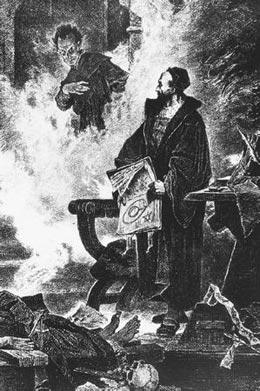
Worries about an apocalypse unleashed by particle accelerators are not new, says Philip Ball. They have their source in old myths, which are hard to dispel.
When physicists dismiss as a myth the charge that the Large Hadron Collider (LHC) will trigger a process that might destroy the world, they are closer to the truth than they realize.
In common parlance, a myth has come to denote a story that isn’t true, but in fact it is a story that is 'psychologically true'. A myth is not a false story but an archetypal one. And the archetype for this current bout of scare stories is obvious: the Faust myth, in which an hubristic individual unleashes forces he or she cannot control.
The LHC is due to be switched on this summer at CERN, the European centre for particle physics near Geneva. But some fear that the energies released by colliding subatomic particles will produce miniature black holes that will engulf the world. Walter Wagner, a resident of Hawaii, has even filed a lawsuit to prevent the experiments.
As high-energy physicist Joseph Kapusta from the University of Minnesota in Minneapolis points out1, such dire forebodings have accompanied the advent of other particle accelerators, including the Bevalac in California and the Relativistic Heavy Ion Collider (RHIC) in New York. In the latter case, newspapers seized on the notion of an apocalyptic event — just as the facility went into operation, Britain's Sunday Times ran a story under the headline The Final Experiment?
Swallowing Earth
The Bevalac, an amalgamation of two existing accelerators at the Lawrence Berkeley National Laboratory, was created in the 1970s to investigate extremely dense states of nuclear matter — stuff made from the compact nuclei of atoms. In 1974, two physicists proposed that there might be a hitherto unseen and ultra-dense form of nuclear matter more stable than ordinary nuclei, which they rather alarmingly dubbed ‘abnormal’. If so, there was a small chance that even the tiniest lump of it could keep growing indefinitely by engulfing ordinary matter. Calculations implied that a speck of this pathological form of abnormal nuclear matter made in the Bevalac would sink to the centre of Earth and then expand to swallow the planet, all in a matter of seconds.
No one, Kapusta says, expected that abnormal nuclear matter, if it existed, would really have this voracious character — but neither did anyone know enough about the properties of nuclear matter to rule it out. According to physicists Subal Das Gupta from McGill University in Montreal, Canada, and Gary Westfall at Michigan State University in East Lansing, who wrote about the motivations behind the Bevalac to mark its termination in 19932, “Meetings were held behind closed doors to decide whether or not the proposed experiments should be aborted.”
The RHIC, at the Brookhaven National Laboratory, began operating in 1999 mainly to create another predicted super-dense form of matter called a quark–gluon plasma. This is thought to have been what the Universe consisted of less than a millisecond after the Big Bang. After an article about it was published in Scientific American 3, worries were raised about whether matter this dense might collapse into a mini black hole that would again then grow to engulf the planet.
Strange, but true?
“And yet, might there really be some substance to these fears?”
Physicist Frank Wilczek at the Massachusetts Institute of Technology in Cambridge dismissed this idea as “incredible”, but at the same time he raised a new possibility: the creation of another super-dense, stable form of matter called a strangelet that could also be regarded as a potential Earth-eater. In a scholarly article published in 2000, Wilczek and several colleagues analysed all the putative risks posed by the RHIC, and concluded that none posed the slightest real danger4.
But isn’t this just what we would expect high-energy physicists to say? That objection was raised by Richard Posner, a distinguished professor of law at the University of Chicago in Illinois5. He argued that scientific experiments that pose potentially catastrophic risks, however small, should be reviewed in advance by an independent board. He recognized that current legal training provides lawyers and judges with no expertise for making assessments about scientific phenomena “of which ordinary people have no intuitive sense whatsoever”, and asserted that such preparation is therefore urgently needed.
It seems reasonable to insist that, at the very least, such research projects commission their own expert assessment of risks, as is routinely done in some areas of bioscience. The LHC has followed the example of the RHIC in doing just that. A committee has examined the dangers posed by strangelets, black holes and the effects of possible ‘hidden’ extra dimensions of space. In 2003, it concluded that there is “no basis for any conceivable threat” from the accelerator’s high-energy collisions6.
Runaway gloop
These scare stories are not unique to particle physics. When in the late 1960s Soviet scientists mistakenly thought they had found a new, waxy form of pure water called polywater, one scientist suggested that it could ‘seed’ the conversion of all the world’s oceans to gloop — a scenario memorably anticipated in Kurt Vonnegut’s 1963 novel Cat’s Cradle, in which the culprit was instead a new form of ice. Super-viruses leaked from research laboratories are a favourite source of rumour and fear — this was one suggestion for the origin of AIDS. And nanotechnology was accused of hastening doomsday thanks to one commentator’s fanciful vision of grey goo: replicating nanoscale robots that disassemble the world for raw materials from which to make copies of themselves.
In part, the appeal of these stories is simply the frisson of an eschatological tale, the currency of endless disaster movies. But it is also noteworthy that these are human-made apocalypses, triggered by the heedless quest for knowledge about the Universe.
 Myths like that of Faust (here the 1865 Johann Wolfgang Goethe edition) are long-lived.
Myths like that of Faust (here the 1865 Johann Wolfgang Goethe edition) are long-lived.This is the template that became attached to the Faust legend. Initially a folk tale about an itinerant charlatan with roots that stretch back to the Bible, the Faust story was later blended with the myth of Prometheus, who paid a harsh price for daring to challenge the gods because of his thirst for knowledge. Goethe’s Faust embodied this fusion, and Mary Shelley popularized it in Frankenstein, which she explicitly subtitled ‘Or The Modern Prometheus’. Roslynn Haynes, a professor of English literature, has explored how the Faust myth shaped a common view of the scientist as an arrogant seeker of dangerous and powerful knowledge7.
All this sometimes leaves scientists weary of the distrust they engender, but Kapusta points out that it is occasionally even worse than that. When Das Gupta and Westfall wrote about the concerns of abnormal nuclear matter raised with the Bevalac, they were placed on the US Federal Bureau of Investigation’s ‘at risk’ list of individuals thought to be potential targets of the Unabomber. Between 1978 and 1995, the bomber — a mathematician living in a forest shack in Montana — sent bombs through the US mail to scientists and engineers he considered to be working on harmful technologies. A lawsuit by a disgruntled Hawaiian seems mild by comparison.
Risky business
And yet, might there really be some substance to these fears? During the Manhattan Project that developed the atomic bomb, several of the scientists involved were a little unsure — until they saw the mushroom cloud of the Trinity test — whether the explosion might not trigger runaway combustion of Earth’s atmosphere.
The RHIC and LHC have taken much less on trust. But of course the mere acknowledgement of the risks that is implied by commissioning studies to quantify them, along with the fact that it is rarely possible to assign any such risk a strictly zero probability, must itself fuel public concern. And it is well known to risk-perception experts that we do not have the ability to make a proper rating of very rare but very extreme disasters, even to the simple extent that we feel mistakenly safer in our cars than in an aeroplane.
That is why Kapusta’s conclusion that “physicists must learn how to communicate their exciting discoveries to non-scientists honestly and seriously”, commendable though it is, can never provide a complete answer. We need to recognize that these fears have a mythic dimension that rational argument can never wholly dispel.



1 comment:
Excellent article, the relevant points below are in rebuttal form...
CERN predicts the creation of up to 1 micro black hole per second in the Large Hadron Collider and references the 1999 RHIC safety study as proof of safety.
(Rebuttal: But the 1999 RHIC safety study only ruled out any possibility of colliders creating micro black holes based on knowledge at that time.)
CERN predicts that micro black holes will evaporate.
(Rebuttal: But Hawking Radiation has been disputed by no less than 3 peer reviewed studies that found no basis in science for such conclusions.)
CERN and Steven Hawking state that much greater energy cosmic ray impacts with Earth prove safety.
(Rebuttal: But higher energy cosmic ray impacts with stationary particles have net collision speeds of almost the speed of light and send all particles created safely into space, while head-on collider collisions have net collision impact speeds at almost twice the speed of light but are designed to focus all the energy to a single point in space and particles created may be captured by Earth's gravity.)
CERN promised to create and release an new safety report before the end of 2007.
(Rebuttal: CERN's LHC Safety Assessment Group has concluded that particles created by cosmic ray impacts with Earth's atmosphere are safely ejected into space and LSAG stated that they do not assume that micro black holes will evaporate, but CERN never released any safety reports created by their LHC Safety Assessment Group.)
CERN asserts that there is no risk to the planet, even though the Large Hadron Collider will create conditions not seen in nature since the first fraction of a second after the big bang.
(Rebuttal: But the legal action contends a 75% probability of risk with very high degree of uncertainty calculated by a scientist with a masters degree in statistics, and alleges that Chief Scientific Officer Mr. Engelen passed an internal memorandum to workers at CERN asking them regardless of personal opinion to affirm in all interviews that there were no risks involved in the experiments, changing CERN's previous assertion of minimal risk.)
Professor Otto Rossler calculates that a single micro black hole could accrete the Earth is as few as 50 months and Dr. Rossler is world recognized as one of the most prestigious, most eminent, award winning scientists alive. Others including Dr. Raj Baldev, director of the Indira Gandhi Center for Atomic Research, are also warning of a very real, very possible, very present danger to the planet from the Large Hadron Collider.
(Rebuttal?: But CERN has not scientifically refuted his calculations that I am aware of, CERN only promised Dr. Rossler that if they create stable micro black holes that they will stop the experiment immediately. But could that be too late?)
The World might prevent a catastrophy if we delay the experiment until the promised safety studies are completed and peer reviewed.
(Rebuttal?: But then some scientists may not be the first to discover new science and some Nobel prizes may be lost?)
JTankers
LHCConcerns.com
Post a Comment